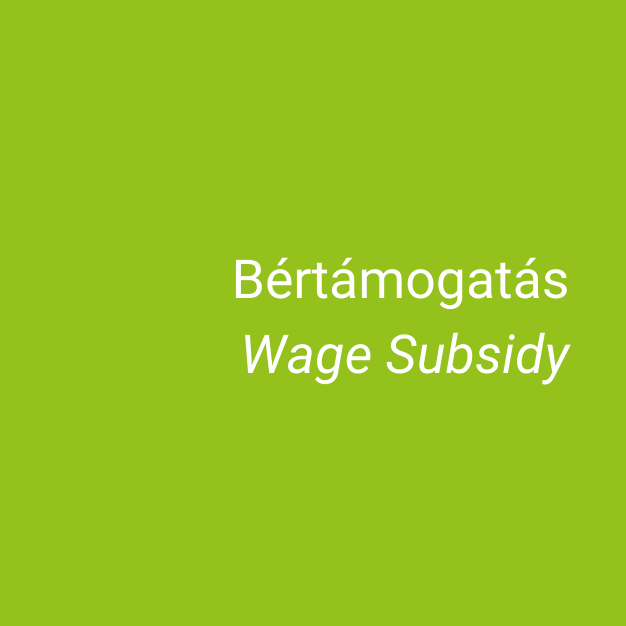
1. Who can draw on wage subsidies and for whom?
Basically, this option is open to economic enterprises (Ltd., general partnerships, etc.). Organizations working in the social and civil spheres already have this option according to the government spokesman, but this has not been amended in the decree yet. If you want to apply for the subsidy as an association or non-governmental organization, consult with your payroll accountant. This subsidy applies to employees, so, for example, to those working under a service contract or in a business partnership not. It can be utilized for people who have at least been employed by an employer from before 11 March 2020 (i.e. the day when the pandemic situation was announced).
2. From when and for how long can the subsidy be utilized?
The interface where the subsidy can be applied for was opened on April 16, 2020 on website nfsz.munka.hu, and it can be submitted jointly by the employee and the employer through the employer’s Company Gate account. The amended decree was published on 21 April and will enter into force after the 8th day, so it is not worth submitting the application before that, because then the old conditions will still apply. There are several statements that must be filled out and signed by the employee and sent to the employer.
The subsidy can be utilized from 01 May 2020 for full months with ex-post financing. The subsidy can be utilized for three months and will be paid to the employee on a net basis, free of social charges, for 70 percent of the time lost.
The concept of reduced working time has also been changed according to the amended decree: according to the employment contract to be amended after the announcement of the emergency, on a three-month average, part-time work corresponding to at least twenty-five percent of the working time included in the employment contract prior to the amendment but not exceeding eighty-five percent: i.e. minimum 2, maximum 6.8 hours.
An important change is that everything will have to be calculated on the basic salary and not on the absentee fee.
3. How does the modified structure of the subsidy look like?
According to the amended decree, working time can consist of three parts, depending on whether personal development salary is required to be paid or not.
The new amended decree states that if the reduction in working time is more than half of the previous working time, i.e. for example, working time is reduced to 2 or maximum 4 hours from 8, it is not mandatory to pay personal development salary, which is only an option.
This is a very positive change compared to the previous one, where the employer was obliged to pay amount this additionally.
Option 1:
If the reduced working time is more than half of the original working time, i.e. 8 hours is reduced to 5 hours a day:
in this case, the mandatory personal development time under the original decree and the mandatory commitment to keep the employee’s original net basic salary remain.
• There will be a reduced working time which is part-time work corresponding to at least twenty-five percent of the working time under the employment contract prior to the amendment in a three months average, but not exceeding eighty-five percent.” This is 5 hours in this case, so the lost time will be 3 hours.
• There will be an personal development time: “the employee is exempted from the obligation to work to the extent of thirty percent of the time lost due to reduced working hours in order to develop his or her sphere of work or the activity of the employer and is available to the employer during the personal development time.”
What does this mean for 5 working hours a day?
30% of the lost time, i.e. 3 hours, 3*0,3 = 0.9 hour a day will be the personal development time. This will be paid by the employer above the 5 hours according to the decree, as the rule says that the employer agrees to pay wage for the personal development time and together with the subsidy the “new” net wage of the employee will equal the “old” net wage. During this development time, the employee must be available, but does not have to do work, but must develop him/herself, either by him/herself or based on the tasks assigned by his/her employer.
• There will be a time for subsidy, which is seventy percent of the time lost. Using our example, the loss of time is 3 hours, 70% of which is 2.1 hours a day. This will be subsequently transferred by the government as a net wage, a subsidy to the employee and the employee will not have to be available for work during this time (but this is not factually stated, it only follows from certain statements).
So, we can already see that the previous 8 hours of working time per day will consist of 3 elements: 5 hours of working time, 0.9 hour of personal development time when the employee shall develop him/herself and 2.1 hours of subsidy.
Option 2: this is what has changed according to the amendment and made the subsidy much more favorable:
If the reduced working time does not exceed half of the working time under the employment contract prior to the amendment, the employee and the employer may agree on personal development time, i.e. if the 8-hour working time is reduced to 2 to 4 hours, no personal development time has to be paid, it is only an option and the original basic salary does NOT have to be retained.
Let’s see how working hours change when working time is halved:
The reduced working time that the employer will continue to pay will be 4 hours.
As this will not exceed half of the employee’s previous working time, it will be not mandatory to pay personal development time and the working time for this will be “0” hour.
The working time for subsidy will be the lost working time, i.e. 4 hours.
4. What is the amount of the subsidy and, in practice, what are the employer’s labor costs if the subsidy is utilized in the case of a corporate taxpayer, paying social contributions?
Simply put, the subsidy rate is 70% of the net wage for the lost time, but no more than twice the net minimum wage. Let’s look at this through two examples, but first let’s calculate the maximum amount of subsidy that can be given if working hours are reduced from 8 to the maximum possible 2.
70% of twice the loss of time of the minimum wage calculated as net wages, i.e. HUF 161.000 * 2 * 0,7 *0,75 *0,665= HUF 112,418.
Thus, the government provides a maximum net amount of HUF 112,418 per month to the employee as subsidy. This is also a favorable change compared to the previous maximum of HUF 74,945.
| Example 1, where the daily working time is reduced from 8 hours to 4 and personal development time does NOT have to be paid and the basic salary does NOT have to be supplemented:The gross salary is HUF 250,000 for 8 hours a day according to the corporate income taxation, with social contribution: The employer’s total cost per month before the crisis: HUF 297.500. The employee’s net salary before the crisis: HUF 166.250. The employer reduced the working hours to 4 because of the pandemic, so the gross salary became HUF 125.000, the total cost: HUF 148.750. The employee’s reduced net salary: HUF 83.125.They draw on the subsidy and therefore: The employer decides not to pay for personal development time, so the employer will not have additional costs in this case. The employee receives net 70% of the HUF 125,000 for the loss of time from the government, which is HUF 58,187, which falls within the HUF 112,418 limit. Thus, the employee’s net salary will be HUF 143,312. |
| Example 2, where the daily working time is reduced from 8 hours to 5 and thus personal development time has to be paid and the basic salary has to be supplemented:The gross salary is HUF 250,000 for 8 hours a day according to the corporate income taxation, with social contribution:
The employer’s total cost per month before the crisis: HUF 297,500. They draw on the subsidy and therefore: So, the employee gets the same salary as before, but let’s see how much it cost the employer. Before the reduction, the 8-hour salary cost the employer HUF 297,500. |
5. What should an employer undertake in return for the subsidy?
If the reduction of the working time is more than half of the original working time, the employer does not have to undertake to pay salary for personal development time and supplement the original basic salary.
If the reduction of the working time is less than half of the original working time, the employer has to pay salary for personal development time and supplement the original basic salary.
The employer also has to undertake not to give notice to the employee for the 3-month period of the subsidy and for an additional month with ordinary termination. Failure to do so will result in a payment by decision, but the rate of this is not specified in the decree.
An important change is that the retention requirement applied for the entire statistical headcount, but it will only apply to the subsidized employees.
6. What happens if the subsidy is not granted?
The decree states that the government office will examine the applications within 8 working days and decide which cannot be contested and cannot be challenged in court either. If rejected, the application can be submitted once more.
So, in fact, the rejection does not have to be justified, because there is no possibility for a legal remedy, i.e. there is no legal binding force that would guarantee that the government office will only reject the subsidy with good reason. If it is rejected, there is really nothing that can be done, it must be accepted.
7. Is it necessary to make any agreement between the employer and the employee about this?
The amended decree also provided an advantage in this respect: it is no longer necessary to amend the employment contract of each and every employee, but by virtue of the amended decree, the contract is amended with the subsidy for the duration of the subsidy.
However, it is important to note that if the employment contract is not amended, it will automatically return to its original terms and conditions once the crisis is over. So if someone thinks that it is possible that he will only be able to work for the reduced working hours after the crisis, he should amend his employment contract (certainly by mutual agreement).
8. What further amendments and concessions have been included in the decree?
Summarizing the details of the previous and the amended decree in a table, we can see that a much more favorable provision has been made that is safer for the employers.There is still a great deal of uncertainty about the practicalities of the subsidy and it is certain that companies will need a lot of guidance from the government. That is why this article only tried to summarize the pros and cons but did not fully discuss the decree and therefore does not constitute specific advice.

Always consult your payroll accountant, if you want to apply for a subsidy.
Can we help you? Visit our payroll accounting services page to see how we can support your business.



